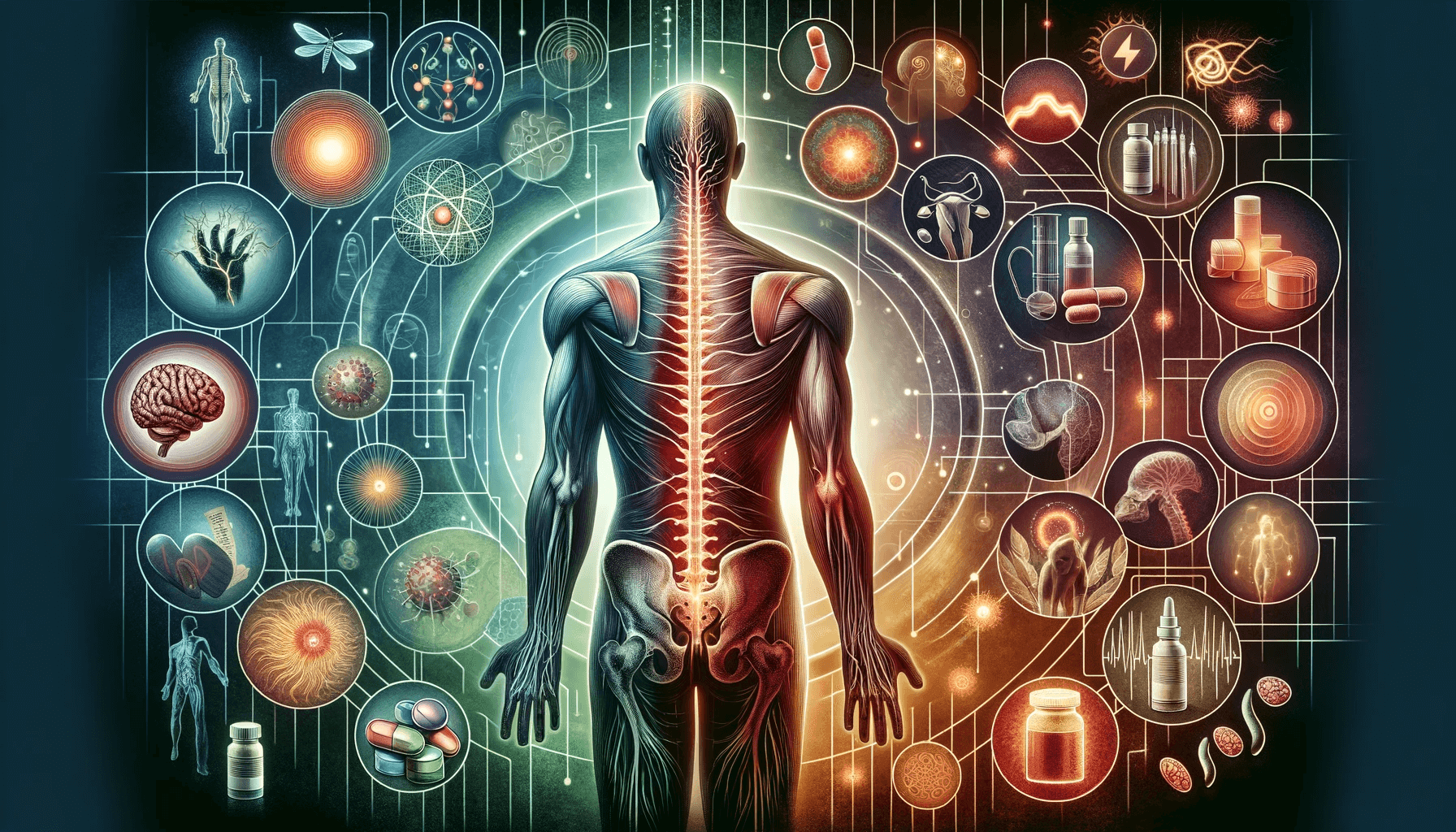Sponsor Chronic Kidney Disease Solution CKD
Table of Contents
Chronic pain is a debilitating condition that affects millions of people worldwide. It is characterized by persistent pain that lasts for more than three months and can significantly impact a person’s quality of life. In this article, we will delve into the causes of chronic pain and the different types and explore effective treatment options to manage this condition.
What is Chronic Pain?
Chronic pain is defined as pain that persists for over three months beyond the expected healing time. Unlike acute pain, a warning signal for tissue damage, chronic pain is often not associated with any evident injury or illness. It can affect any part of the body and can range from mild to severe. Chronic pain can have a profound impact on a person’s physical and mental well-being, leading to decreased mobility, sleep disturbances, and emotional distress.
Common Causes of Chronic Pain
Chronic pain can arise from various underlying conditions or factors. Some common causes include:
1. Injury or Trauma: Chronic Pain can develop due to a previous injury or trauma, such as a car accident, sports injury, or surgery. In some cases, the pain persists long after the initial healing process.
2. Medical Conditions: Certain medical conditions, such as fibromyalgia, arthritis, neuropathy, and cancer, can lead to chronic pain. These conditions affect the nerves, joints, or muscles, causing ongoing discomfort.
3. Inflammation: Chronic inflammation can trigger pain that persists over an extended period. Conditions like rheumatoid arthritis, inflammatory bowel disease, and chronic sinusitis can cause chronic pain due to ongoing inflammation in the affected areas.
4. Nervous System Disorders: Disorders affecting the nervous system, such as multiple sclerosis, can result in chronic pain. Nerve damage or dysfunction can lead to constant pain signals being sent to the brain.
5. Psychological Factors: Emotional and psychological factors can also contribute to chronic pain. Conditions like depression, anxiety, and post-traumatic stress disorder (PTSD) can exacerbate pain perception and make it more challenging to manage.
Understanding the Different Types of Chronic Pain
Chronic pain can manifest in various forms, each with its unique characteristics. Here are some common types of chronic Pain:
1. Nociceptive Pain: This type stems from tissue damage or inflammation and is often described as a sharp, throbbing, or aching sensation. It can be localized or widespread, depending on the underlying cause.
2. Neuropathic Pain: Neuropathic Pain occurs when there is damage or dysfunction in the nervous system. It is often described as a burning, shooting, or electric shock-like sensation. Conditions like diabetic neuropathy and sciatica are examples of neuropathic pain.
3. Central Sensitization Pain: Central sensitization pain is characterized by an amplified response to stimuli that are typically non-painful. It can result from conditions like fibromyalgia and is associated with widespread pain throughout the body.
4. Psychogenic Pain: Psychogenic Pain is primarily influenced by psychological factors. It is often perceived as real pain, although there may be no identifiable physical cause. Conditions like somatic symptom disorder and conversion disorder fall under this category.
The Impact of Chronic Pain on Daily Life
Chronic pain can significantly impact a person’s daily life in various ways. The constant presence of pain can limit mobility, making it difficult to perform simple tasks or engage in physical activities. Chronic pain can disrupt sleep patterns, leading to fatigue and reduced cognitive function. The emotional toll of chronic pain can result in mood disturbances, such as depression and anxiety, further affecting overall well-being.
Recognizing the Symptoms of Chronic Pain
Chronic Pain symptoms can vary depending on the underlying cause and type of pain experienced. However, some common symptoms include:
1. Persistent Pain: Chronic Pain is characterized by pain that lasts more than three months beyond the expected healing time.
2. Reduced Range of Motion: In some cases, chronic pain can lead to reduced flexibility and limited range of motion in the affected area.
3. Sleep Disturbances: Many individuals with chronic pain experience difficulties in falling asleep or staying asleep, leading to sleep deprivation and daytime fatigue.
4. Emotional Distress: Chronic Pain can contribute to emotional distress, including feelings of frustration, irritability, sadness, and anxiety.
5. Cognitive Impairment: Constant Pain can affect cognitive function, leading to difficulties with concentration, memory, and problem-solving.
Diagnosing Chronic Pain: What to Expect
Diagnosing chronic pain can be a complex process that involves a comprehensive assessment of a person’s medical history, physical examination, and diagnostic tests. Here is what you can expect during the diagnostic process:
1. Medical History: Your healthcare provider will inquire about your symptoms, medical history, and any previous injuries or medical conditions that may contribute to your chronic pain.
2. Physical Examination: A physical examination will assess the affected area and evaluate any signs of pain or inflammation.
3. Diagnostic Tests: Depending on the suspected underlying cause, your healthcare provider may order diagnostic tests such as X-rays, MRIs, CT scans, or blood tests to evaluate the source of your chronic pain further.
Effective Treatment Options for Chronic Pain
Managing chronic pain requires a multidisciplinary approach that combines various treatment modalities. Here are some effective treatment options for chronic pain:
Medications for Managing Chronic Pain
Medications can play a crucial role in managing chronic pain by reducing pain signals and alleviating discomfort. Some commonly prescribed medications for chronic pain include:
1. Nonsteroidal Anti-Inflammatory Drugs (NSAIDs): NSAIDs, such as ibuprofen and naproxen, can help reduce inflammation and relieve pain associated with arthritis and musculoskeletal injuries.
2. Opioids: Opioid medications may be prescribed for severe chronic pain that does not respond to other treatment options. However, these medications should be used cautiously due to the risk of dependence and potential side effects.
3. Antidepressants: Certain antidepressant medications, such as tricyclic antidepressants and selective serotonin reuptake inhibitors (SSRIs), can help manage chronic pain by altering pain perception and improving mood.
Alternative Therapies for Chronic Pain Relief
In addition to medications, alternative therapies can provide additional relief for chronic pain. These therapies focus on holistic approaches to pain management and include:
1. Acupuncture: Acupuncture involves inserting thin needles into specific points on the body to stimulate the release of endorphins, which are natural pain-relieving chemicals.
2. Chiropractic Care: Chiropractic care aims to align the spine and improve overall body function, which can help reduce chronic pain symptoms.
3. Physical Therapy: Physical therapy focuses on exercises and techniques to improve strength, flexibility, and overall function, reducing pain and improving mobility.
4. Massage Therapy: Massage therapy can help relax muscles, improve circulation, and reduce tension, providing temporary relief from chronic pain.
Lifestyle Changes to Alleviate Chronic Pain
Specific lifestyle changes can contribute to managing chronic pain and improving overall well-being. Here are some lifestyle modifications that may help:
1. Regular Exercise: Regular physical activity, such as low-impact exercises and stretching, can help improve strength and flexibility and manage chronic pain.
2. Healthy Diet: A well-balanced diet with anti-inflammatory foods, such as fruits, vegetables, whole grains, and lean proteins, may help alleviate chronic pain.
3. Stress Management: Chronic Pain can be exacerbated by stress. Practicing stress management techniques, such as deep breathing exercises, meditation, and mindfulness, can help reduce stress levels and alleviate pain.
4. Adequate Sleep: Prioritizing good sleep hygiene and establishing a consistent sleep routine can improve pain management and overall well-being.
The Importance of a Multidisciplinary Approach to Chronic Pain Management
Managing chronic pain often requires a multidisciplinary approach involving a team of healthcare professionals with expertise in pain management. This approach ensures that all aspects of the condition, including physical, psychological, and social factors, are addressed comprehensively. A multidisciplinary pain management team may include:
1. Physicians: Physicians specialized in pain management can diagnose and develop treatment plans tailored to the specific needs of individuals with chronic pain.
2. Physical Therapists: Physical therapists can provide exercises, manual therapy, and other techniques to improve mobility, strength, and function.
3. Psychologists: Psychologists can help individuals develop coping strategies, address emotional distress, and manage the psychological impact of chronic pain.
4. Occupational Therapists: Occupational therapists can assist in improving daily functioning and finding adaptive strategies to manage chronic pain.
Coping Strategies for Living with Chronic Pain
Living with chronic pain can be challenging, but there are coping strategies that can help individuals manage their pain and improve their quality of life. Here are some coping strategies to consider:
1. Relaxation Techniques: Relaxation techniques, such as deep breathing, progressive muscle relaxation, and guided imagery, can help reduce pain and promote relaxation.
2. Distraction Techniques: Engaging in activities that divert attention from the pain can be helpful. This can include hobbies, listening to music, reading, or spending time with loved ones.
3. Support Groups: Joining a support group or seeking counseling can provide a sense of community and support from others who understand the challenges of living with chronic pain.
4. Mindfulness and Meditation: Practicing mindfulness and meditation can help individuals become more aware of their pain sensations without judgment, reducing the emotional impact of chronic pain.
Seeking Support for Chronic Pain Management
Living with chronic pain can be isolating, and seeking support is crucial for overall well-being. Here are some resources to consider:
1. Support Groups: Local support groups or online communities can provide a space for individuals to share experiences, gain support, and exchange coping strategies.
2. Counseling and Therapy: Seek psychological support from therapists or counselors specializing in chronic pain management.
3. Patient Advocacy Organizations: Many organizations focus on chronic pain management and offer resources, education, and support to individuals with chronic pain.
Research and Advancements in Chronic Pain Treatment
Research in chronic pain management is continually evolving, leading to advancements in treatment options. Scientists and medical professionals are exploring new therapies, medications, and interventions to provide better pain relief and improve the quality of life for individuals with chronic pain.
Conclusion
Chronic pain is a complex condition that affects millions of people worldwide. It is essential to understand its causes, symptoms, and treatment options for effective pain management. By adopting a multidisciplinary approach, incorporating various treatment modalities, and implementing lifestyle changes, individuals with chronic pain can find relief and improve their overall well-being. Remember, seeking support, both from healthcare professionals and the chronic pain community, can make a significant difference in managing this challenging condition.





Leave a Reply